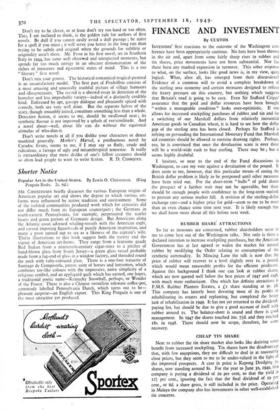FINANCE AND INVESTMENT
By CUSTOS
INVESTORS' first reactions to the outcome of the Washington con- ference have been appropriately cautious. No hats have been thrown in the air and, apart from some fairly sharp rises in rubber and tin shares, price movements have not been substantial. Nor has there been any marked expansion in turnover. This sober response to what, on the surface, looks like good news is, in my view, quite 'logical. What, after all, has emerged from their discussions? Evidence of a common will to avoid a complete breakdown of the sterling area economy and certain measures designed to relieve the heavy pressure on this country, but nothing which suggests that Britain's road is going to be easy. Even Sir Stafford Cripps' assurance that the gold and dollar resources have been brought " within a manageable condition" looks over-optimistic. If one allows for increased stockpiling purchases of rubber and tin and for a switching of our Marshall dollars from relatively inessential American goods to Canadian wheat, it is hard to see how the dollar gap of the sterling area has been closed. Perhaps Sir Stafford is relying on persuading the International Monetary Fund that Marshall aid countries should be allowed to exercise drawing rights. Perhaps, too, he is convinced that once the devaluation scare is over there will be a world-wide rush to buy sterling. There may be ; but it seems highly doubtful.
I hesitate, so near to the end of the Fund discussions in Washington, to cast my vote against a devaluation of the pound. It does seem to me, however, that this particular means of easing the British dollar problem is likely to be postponed until other measures have been tried out. For the short-term " bulls " of gold shares the prospect of a further wait may not be agreeable, but there should be enough people with confidence in the long-term outlook to prevent any serious market fall. A revision of the sterling-dollar. exchange rate—and a higher price for gold—seem to me to be more than an even chance some time next year. It is likely enough that we shall know more about all this before next week.
RUBBER SHARE ATTRACTIONS
So far as investors are concerned, rubber shareholders seem to me to come best out of the. Washington talks. Not only is there a declared intention to increase stockpiling purchases, but the American Government has at last agreed to widen the market for natural rubber by modifying the Order relating to consumption of the synthetic commodity. In Mincing Lane the talk is now that the price of rubber will recover to a level slightly over Is. a pound, which would mean reasonable profits for the efficient producers. Against this background I think one can look at rubber shares, which are now quoted well below the best prices of 1947 and 1948, with much more enthusiasm. One which has definite attractions is F.M.S. Rubber Planters Estates, a £1 share standing at 9s. 3d. This company has latterly been devoting most of its profits to rehabilitating its estates and replanting, but completed the heavy task of rehabilitation in 1949. It has not yet returned to the dividend- paying list, but should be due to give a good account of itself with rubber around is. The balance-sheet is sound and there is good management. In 1947 the shares touched 20S. 71d. and they reached as. in 1948. There should now be scope, therefore, for some recovery.
CHEAP TIN SHARE
Next to rubber the tin share market also looks like deriving some benefit from increased stockpiling. Tin shares have the disadvantage that, with few exceptions, they are difficult to deal in at reasonably close prices, but they seem to me to be under-valued in the light of the improved prospects. A case in point is Kepong Dredging 5;• shares, now standing around 8s. For the year to June 30, 1949, this company is paying a dividend of 20 per cent, so that the yield 15 12.1- per cent., ignoring the fact that the final dividend of to per cent., or 6d. a share gross, is still included in the price. Operating in Malaya the company also has investments in other well-established tin concerns.


































 Previous page
Previous page